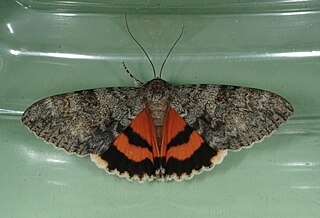
Catocala amatrix, the sweetheart underwing, is a moth of the family Erebidae. The species can be found from Nova Scotia, south through Connecticut to Florida and west through Texas and Oklahoma to Arizona and north to Montana, Minnesota, and Ontario.

Catocala blandula, the charming underwing, is a moth of the family Erebidae. The species was first described by George Duryea Hulst in 1884. It is found in North America from Nova Scotia west to central Alberta, south to Pennsylvania and Wisconsin.

Catocala ultronia, the dark red underwing or ultronia underwing, is a moth of the family Erebidae. The species was first described by Jacob Hübner in 1823. It is found in most of eastern North America, south to Florida and Texas. It ranges west across the southern parts of Canada to extreme southeast British Columbia.

Catocala angusi, commonly known as Angus' underwing, is a species of moth in the family Erebidae. It is found from Massachusetts and Connecticut south to Georgia west to Arkansas and Kansas and north to Illinois and Michigan.

Catocala dejecta, the dejected underwing, is a moth of the family Erebidae. It is found from Massachusetts and Connecticut south through New Jersey to Florida, west to Texas and Oklahoma and north to southern Ontario.
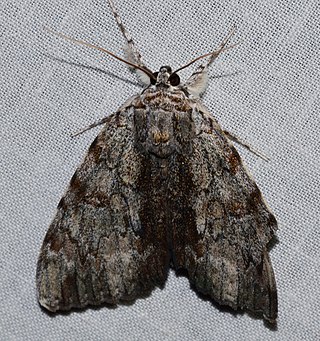
Catocala insolabilis, the inconsolable underwing, is a moth of the family Erebidae. The species was first described by Achille Guenée in 1852. It is found in North America from Ontario through Maine and Connecticut south to Florida, west through Arkansas to Texas and Oklahoma and north to South Dakota.
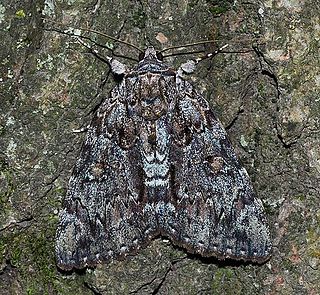
Catocala lacrymosa, the tearful underwing, is a moth of the family Erebidae. It is found from Massachusetts and Connecticut south to Florida, west to Texas and eastern Oklahoma and north to Illinois and Michigan and into southern Ontario.

Catocala badia, the bay underwing, bayberry underwing or old maid, is a moth of the family Erebidae. It is found from southern Maine and New Hampshire south to New York and Connecticut.

Catocala consors, the consort underwing, is a moth of the family Erebidae. It is found from Maine and Connecticut south to Florida and west to Texas and eastern Oklahoma.

Catocala innubens, the betrothed underwing, is a moth of the family Erebidae. The species was first described by Achille Guenée in 1852. It is found in North America from southern Ontario and Quebec south through Michigan, Connecticut, Tennessee to Florida and west to Texas and Oklahoma and north to Wisconsin.
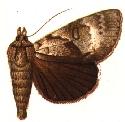
Catocala andromedae, the Andromeda underwing or gloomy underwing, is a moth of the family Erebidae. The species was first described by Achille Guenée in 1852. It is found in the United States from Maine south through New Jersey to Florida and Alabama and west to Texas and Oklahoma.
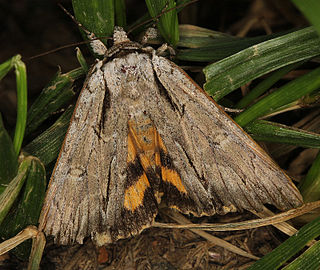
Catocala clintoni, Clinton's underwing, is a moth of the family Erebidae. It is found from Ontario and Quebec, southward to Florida, west to Texas and north to Wisconsin.

Catocala crataegi, the hawthorn underwing or chokeberry underwing, is a moth of the family Erebidae. It is found from Ontario and Quebec to Prince Edward Island south from Maine through Connecticut to Georgia and west to Arkansas and north to Minnesota.

Catocala herodias, the Herodias underwing or Gerhard's underwing, is a moth of the family Erebidae. The species was first described by Strecker in 1876. The nominate form is found in the US states of Texas and Oklahoma. Subspecies Catocala herodias gerhardi is found from Massachusetts, Connecticut, New York to Virginia. The gerhardi subspecies is listed as endangered in Connecticut.

Catocala alabamae, the Alabama underwing or titan underwing, is a moth of the family Erebidae. It is found from Louisiana, Maryland south to Florida, west to Texas and north to Missouri, Wisconsin Pennsylvania and Illinois.

Catocala micronympha, the little nymph underwing or little bride underwing, is a moth of the family Erebidae. The species was first described by Achille Guenée in 1852. It is found in North America from southern Ontario, Quebec, and Manitoba through New Hampshire, Connecticut, and New Jersey to Florida, west to Texas and then north through Oklahoma, Kansas, Iowa, to Wisconsin and Minnesota and then east to Michigan.

Catocala grynea, the woody underwing, is a moth of the family Erebidae. The species was first described by Pieter Cramer in 1780. It is found in North America from Ontario and Quebec through Maine and Connecticut, south to Florida, west to Texas and north through Iowa to Wisconsin and Minnesota.
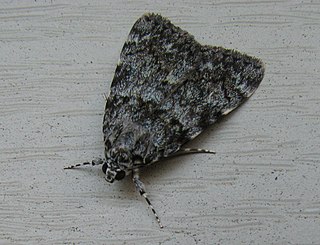
Catocala lineella, the lineella underwing, little lined underwing or steely underwing, is a moth of the family Erebidae. The species was first described by Augustus Radcliffe Grote in 1872. It is found in North America from Ontario and Quebec south to Florida west to Texas and north to Ohio.
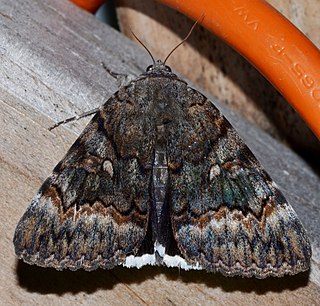
Catocala epione, the Epione underwing, is a moth of the family Erebidae. The species was first described by Dru Drury in 1773. It is found in North America from Quebec and Ontario south through Connecticut to Florida and west to Texas and Oklahoma.

Catocala mira, the wonderful underwing, is a moth of the family Erebidae. The species was first described by Augustus Radcliffe Grote in 1876. It is found in North America from Manitoba through southern Ontario and Quebec through New Hampshire and Connecticut to Florida, west to Texas and north through Iowa and Illinois.














